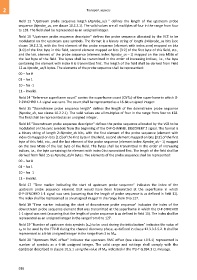Page 926 - 5G Basics - Core Network Aspects
P. 926
2 Transport aspects
Field 12 "Upstream probe sequence length (Nprobe_us) " defines the length of the upstream probe
sequence (Nprobe_us, see clause 10.2.2.1). The valid values are all multiples of four in the range from four
to 128. The field shall be represented as an unsigned integer.
Field 13 "Upstream probe sequence descriptor" defines the probe sequence allocated by the VCE to be
modulated on the upstream sync symbols. The format is a binary string of length 2×Nprobe_us bits (see
clause 10.2.2.1), with the first element of the probe sequence (element with index zero) mapped on bits
[1:0] of the first byte in this field, second element mapped on bits [3:2] of the first byte of this field, etc.,
and the last element of the probe sequence (element index Nprobe_us – 1) mapped on the two MSBs of
the last byte of the field. The bytes shall be transmitted in the order of increasing indices, i.e., the byte
containing the element with index 0 is transmitted first. The length of the field shall be derived from Field
12 as Nprobe_us/4 bytes. The elements of the probe sequence shall be represented:
00 – for 0
01 – for 1
10 – for -1
11 – invalid.
Field 14 "Reference superframe count" carries the superframe count (CNTSF) of the superframe in which O-
P-SYNCHRO 1-1 signal was sent. The count shall be represented as a 16-bit unsigned integer.
Field 15 "Downstream probe sequence length" defines the length of the downstream probe sequence
(Nprobe_ds, see clause 10.2.2.1). The valid values are all multiples of four in the range from four to 128.
The field shall be represented as an unsigned integer.
Field 16 "Downstream probe sequence descriptor" defines the probe sequence allocated by the VCE to be
modulated on the sync symbols from the beginning of the O-P-CHANNEL DISCOVERY 2 signal. The format is
a binary string of length 2×Nprobe_ds bits, with the first element of the probe sequence (element with
index 0) mapped on bits [1:0] of the first byte in this field, second element mapped on bits [3:2] of the first
byte of this field, etc., and the last element of the probe sequence (element index Nprobe_ds – 1) mapped
on the two MSBs of the last byte of the field. The bytes shall be transmitted in the order of increasing
indices, i.e., the byte containing the element with index 0 is transmitted first. The length of the field shall be
derived from field 15 as Nprobe_ds/4 bytes. The elements of the probe sequence shall be represented:
00 – for 0
01 – for 1
10 – for -1
11 – invalid.
Field 17 "Time marker indicating the start of upstream probe sequence" indicates the index of the
upstream probe sequence element that would have been transmitted at the superframe in which
O-P-SYNCHRO 1-1 signal was sent (assuming that the length of probe sequence is as defined in field 12).
The index shall be represented as an unsigned integer in the range from 0 to 127.
Field 18 "Time marker indicating the start of downstream probe sequence" indicates the index of the
downstream probe sequence element that was transmitted at the superframe in which the O-P-SYNCHRO
1-1 signal was sent (assuming that the length of probe sequence is as defined in field 15). The index shall be
represented as an unsigned integer in the range from 0 to 127.
Field 19 "Number of upstream data symbols (sus) to be used during the initialization" indicates the value of
sus to be used by the FTU-R during the channel discovery phase, as defined in clause 12.3.3.3.5.2. It shall be
represented as a 6-bit unsigned integer in the range from 3 to Mus.
Field 20 "Upstream RMC offset" indicates the upstream RMC offset (see clause 10.5.1) represented in
number of symbols as a 6-bit unsigned integer. The valid range and settings shall comply with the
condition described in clause 10.5.1 using the value of Mds indicated in the ITU-T G.994.1 CL message.
916

